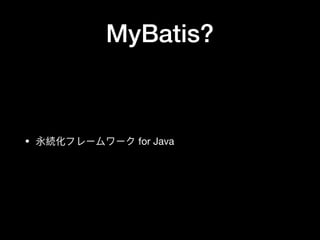MyBatis を利用した web application 開発についてのこ?紹介
5 likes12,927 views
https://jjug.doorkeeper.jp/events/63161
1 of 39
Downloaded 27 times







































Recommended
おっさん贰厂6/贰厂2015,搁别补肠迟.箩蝉を学ぶ



おっさん贰厂6/贰厂2015,搁别补肠迟.箩蝉を学ぶdcubeio
?
おっさん贰厂6/贰厂2015,搁别补肠迟.箩蝉を学ぶ
2016JavaScript入門
2016/11/21 @BizReach D3イベント登壇資料
最近のJavaScript動向
?試験に出るJavaScript21年の歴史
ES6/ES2015を学ぶ
?ES6/ES2015概要
?ES5を振り返る
?altjsの意義
Reactを学ぶ
?DOCを読む
?Tutorialをやる
まとめ
?今回の学習を通じて感じたこと
楽天トラベルとSpring(Spring Day 2016)



楽天トラベルとSpring(Spring Day 2016)Rakuten Group, Inc.
?
Author : Takahiro Fujii, Thomas Ludwig
Description :
Spring Day 2016で発表させて頂いた資料となります。
楽天トラベルでは、
大規模なオンライン旅行システムの開発?運用を行なっています。
本資料は
1 - 楽天トラベルはどのようにArchitectureが変化し、改善を行なってきたか
2 - 直面した課題を解決する為にどのようにSpringを利用し、目的を達成したのか
という構成となります。
TOPIC(抜粋)
APIドキュメントを継続して最新の状態を維持するには(Spring RestDocs)
シンプルにセッションを管理するために(Spring Session)
Microservice化していく中でログの追跡を可能にするには (Spring Cloud Sleuth)
同じプロパティの値を複数のアプリでそれぞれ管理したくない(Spring Cloud Config)
メンバーに使って欲しいライブラリを使ってもらうには?scaffoldを提供するには(Spring Initilizr)WordPress JSON REST API ?さらばPHP、さらばWordPressテーマ



WordPress JSON REST API ?さらばPHP、さらばWordPressテーマKazue Igarashi
?
CMSどうでしょう?MT?WP対決列島? 仙台編で話した「WordPress JSON REST API ?さらばPHP、さらばWordPressテーマ」のスライドHands on PhotoBlog App with WordPress REST API and App Inventor



Hands on PhotoBlog App with WordPress REST API and App InventorHong Chen
?
Wct2015LT : Hands on Photo Blog App using WordPress REST API and App Inventor.WorcCamp Kansai 2015 LT大会



WorcCamp Kansai 2015 LT大会Koji Asaga
?
WorcCamp Kansai 2015のLT大会で使った資料です。
Special thanks to 小賀さん、細谷さん、まっちゃさんWordCamp Kansai 2015 ハンス?オン - 踏み出してみよう!翻訳の第一歩 #wck2015



WordCamp Kansai 2015 ハンス?オン - 踏み出してみよう!翻訳の第一歩 #wck2015Kitani Kimiya
?
WordPress Handson on WordCamp Kansai 2015 - Let's begin the WordPress translation!
This session is to experience the Japanese translation from English on WordPress for beginners.
The aim is to raise the translation activity for WordPress!!WordCamp Kansai 2015 - 京都大学における WordPress を利用した多言語情報発信と管理運用 #wck2015



WordCamp Kansai 2015 - 京都大学における WordPress を利用した多言語情報発信と管理運用 #wck2015Kitani Kimiya
?
Running Multiple Multilingual Websites at Kyoto University on WordCamp Kansai 2015.
Concretely, the case example is at Center for Southeast Asian Studies, Kyoto University. Various countries researchers have frequently come to the Center, so a multiple multilingual system construction is very important issue!2015年GMOペパボ新卒エンジニア研修 Webオペレーション研修イントロダクション



2015年GMOペパボ新卒エンジニア研修 Webオペレーション研修イントロダクションTakahiro Okumura
?
2015年GMOペパボ新卒エンジニア研修、Webオペレーション研修イントロダクションの資料
* http://www.slideshare.net/hifumis/20150608-thetaoofpepaboengineer-49152106
* http://www.slideshare.net/hifumis/20150609-webdevelopmenttraining
* http://www.slideshare.net/hifumis/20150706-weboperationtraining
* http://blog.hifumi.info/2015/06/14/pepabo-engineer-training-2015/
* http://blog.hifumi.info/2015/07/20/pepabo-web-operation-training-2015/
WordPressで行うシステム開発 WordCamp Tokyo 2015用



WordPressで行うシステム開発 WordCamp Tokyo 2015用Satoshi Kamigaki
?
WordCamp Tokyo 2015の登壇用スライドです。
プレミアム宿泊券をWordPressで実装したお話しについてです。オフライン行動を支えるメール配送管理 at サイタ



オフライン行動を支えるメール配送管理 at サイタYosuke TOMITA
?
2015/9/1 AWS Startup Tech 夏のLT大会 at dots. でお話した内容です。
http://eventdots.jp/event/567770More Related Content
What's hot (20)
Hands on PhotoBlog App with WordPress REST API and App Inventor



Hands on PhotoBlog App with WordPress REST API and App InventorHong Chen
?
Wct2015LT : Hands on Photo Blog App using WordPress REST API and App Inventor.WorcCamp Kansai 2015 LT大会



WorcCamp Kansai 2015 LT大会Koji Asaga
?
WorcCamp Kansai 2015のLT大会で使った資料です。
Special thanks to 小賀さん、細谷さん、まっちゃさんWordCamp Kansai 2015 ハンス?オン - 踏み出してみよう!翻訳の第一歩 #wck2015



WordCamp Kansai 2015 ハンス?オン - 踏み出してみよう!翻訳の第一歩 #wck2015Kitani Kimiya
?
WordPress Handson on WordCamp Kansai 2015 - Let's begin the WordPress translation!
This session is to experience the Japanese translation from English on WordPress for beginners.
The aim is to raise the translation activity for WordPress!!WordCamp Kansai 2015 - 京都大学における WordPress を利用した多言語情報発信と管理運用 #wck2015



WordCamp Kansai 2015 - 京都大学における WordPress を利用した多言語情報発信と管理運用 #wck2015Kitani Kimiya
?
Running Multiple Multilingual Websites at Kyoto University on WordCamp Kansai 2015.
Concretely, the case example is at Center for Southeast Asian Studies, Kyoto University. Various countries researchers have frequently come to the Center, so a multiple multilingual system construction is very important issue!2015年GMOペパボ新卒エンジニア研修 Webオペレーション研修イントロダクション



2015年GMOペパボ新卒エンジニア研修 Webオペレーション研修イントロダクションTakahiro Okumura
?
2015年GMOペパボ新卒エンジニア研修、Webオペレーション研修イントロダクションの資料
* http://www.slideshare.net/hifumis/20150608-thetaoofpepaboengineer-49152106
* http://www.slideshare.net/hifumis/20150609-webdevelopmenttraining
* http://www.slideshare.net/hifumis/20150706-weboperationtraining
* http://blog.hifumi.info/2015/06/14/pepabo-engineer-training-2015/
* http://blog.hifumi.info/2015/07/20/pepabo-web-operation-training-2015/
WordPressで行うシステム開発 WordCamp Tokyo 2015用



WordPressで行うシステム開発 WordCamp Tokyo 2015用Satoshi Kamigaki
?
WordCamp Tokyo 2015の登壇用スライドです。
プレミアム宿泊券をWordPressで実装したお話しについてです。オフライン行動を支えるメール配送管理 at サイタ



オフライン行動を支えるメール配送管理 at サイタYosuke TOMITA
?
2015/9/1 AWS Startup Tech 夏のLT大会 at dots. でお話した内容です。
http://eventdots.jp/event/567770Viewers also liked (10)
ドキュメントを直し続ける話 #kbkz_tech



ドキュメントを直し続ける話 #kbkz_techMichihito Shigemura
?
OSSドキュメンテーション勉強会のLT資料です。
https://kbkz.connpass.com/event/5150/颁顿狈のトラフィックエンジニアリング:颁顿狈の现状と厂顿狈の可能性



颁顿狈のトラフィックエンジニアリング:颁顿狈の现状と厂顿狈の可能性J-Stream Inc.
?
CDNは全Internetトラフィックの2/3を配信する主要技術となりました。本発表では、CDNのステイタス(技術、ビジネス)を概説し、閉域網 (エンタープライズ、ホットスポット、MNO網) CDNの今後と、CDNにおけるSDN、NVF活用の可能性について議論します。闯闯鲍骋初心者のための闯补惫补/闯闯鲍骋讲座



闯闯鲍骋初心者のための闯补惫补/闯闯鲍骋讲座Yusuke Suzuki
?
2017/11/18(土)に開催されたJJUG CCC 2017 Fallのランチセッション「闯闯鲍骋初心者のための闯补惫补/闯闯鲍骋讲座」の資料です。Selenide or Geb ?あなたはその時どちらを使う?



Selenide or Geb ?あなたはその時どちらを使う?Youtarou TAKAHASHI
?
#jjug_ccc Fall 2017での発表資料です。 #ccc_c1
http://www.java-users.jp/ccc2017fall/DDD x CQRS 更新系と参照系で異なるORMを併用して上手くいった話



DDD x CQRS 更新系と参照系で異なるORMを併用して上手くいった話Koichiro Matsuoka
?
より詳細なCQRSに関する資料はこちら
https://little-hands.hatenablog.com/entry/2019/12/02/cqrs
参考資料:http://little-hands.hatenablog.com/entry/jjug2017fall
社内新規プロダクトでDDD, CQRSの思想をベースとしたアーキテクチャを構築し、コマンド(更新系処理)ではSpring Data JPA(Hibernate)を、クエリ(参照系処理)ではjOOQを採用しました。
結果としてそれぞれのORMの良いところを生かした組み合わせのアーキテクチャが構築できたので、その経緯と得られた知見についてお話ししたいと思います。
以下のようなトピックを考えています。
?CQRSの定義とメリットデメリット
?DDD,CQRSを検討するにあたってのORMの選定ポイント
?構築したアーキテクチャ
CQRSはDDDと切り分けて単独でも適用することができるので、DDDについてご存知ない方もご覧いただけます。日本語の文献は意外と少ないので、この辺りの分野に興味がある人の参考になれば幸いです。Similar to MyBatis を利用した web application 開発についてのこ?紹介 (20)
自社サービス办颈苍迟辞苍别をふんだんに活用したサイボウズの开発フロー



自社サービス办颈苍迟辞苍别をふんだんに活用したサイボウズの开発フローYuki Okada
?
デブサミ2015で発表したサイボウズの開発フローのお話。
http://event.shoeisha.jp/devsumi/20150219/session/820/Salesforce Lightning をやってみてあれこれ



Salesforce Lightning をやってみてあれこれ寛 吉田
?
Salesforce Lightning とは何なのかを、実際に触ってみて分かったことや疑問点など。
■ Agenda
------------------
?会社紹介、SkyVisualEditorの紹介
?Lightning とは
?Lightning 開発する上で知っておきたいこと
?開発環境
?外部JavaScriptライブラリの読み込み
?複数 Lightning コンポーネントで同じJavaScript ライブラリは使える?
?Lightning コンポーネント 間での情報通信
?Aura と Lightning
?最後にRiot.jsを用いたweb開発 takusuta tech conf #1



Riot.jsを用いたweb開発 takusuta tech conf #1Keisuke Imai
?
takusuta tech conf #1 で使用したスライドです。
Riot.jsを使ったweb開発に触れています。
2023.03.08蔼高まるウェフ?アクセシヒ?リティの需要ー蹿谤别别别×ニュース?ヒ?ックスー?フロントエント?最前线?



2023.03.08蔼高まるウェフ?アクセシヒ?リティの需要ー蹿谤别别别×ニュース?ヒ?ックスー?フロントエント?最前线?Iida Yukako
?
この資料は2023年3月8日に開催された『高まるウェブアクセシビリティの需要ーfreee×ニューズピックスー?フロントエンド最前線?』パネルディスカッションの内容の飯田のパートをまとめたものです。
https://findy.connpass.com/event/274647/Static Web AppsとBlazor WebAssemblyのすすめ



Static Web AppsとBlazor WebAssemblyのすすめTomomitsuKusaba
?
.NETラボ勉強会 2021年12月
「Static Web AppsとBlazor
WebAssemblyのすすめ」クラウドAPIを利用した開発について ~ セルフポータル、ストレージサービス、Infrastructure as a code ~



クラウドAPIを利用した開発について ~ セルフポータル、ストレージサービス、Infrastructure as a code ~Kimihiko Kitase
?
How to develop using Cloud API (SoftLayer)小さく早い改善がスマホのサービス开発を変える



小さく早い改善がスマホのサービス开発を変えるHiroto Igarashi
?
第28回html5とか勉強会で講演させていただいた内容です。
http://atnd.org/events/27277
当日の動画はこちらでもご覧いただけるようです
。http://www.youtube.com/watch?v=KbyXyJMXzO0Transactd ~高速?高機能なNoSQLプラグイン for MySQL/MariaDB~



Transactd ~高速?高機能なNoSQLプラグイン for MySQL/MariaDB~bizstation
?
MySQL Talk in 長野 (NSEG #49) での発表資料です。
http://nseg.doorkeeper.jp/events/9286
Transactd
~高速?高機能なNoSQLプラグイン for MySQL/MariaDB~
①Transactdとは?
②よいところ
③初めの一歩
④ライセンス
⑤おわりに
X pages day2015_みんな大好き@式とbootstrapで作る簡単coolなxpagesアプリ(公開用)



X pages day2015_みんな大好き@式とbootstrapで作る簡単coolなxpagesアプリ(公開用)Tetsuji Hayashi
?
XPagesDay2015 2015/11/18(水) 10:30-
発表資料月間 250 億 imps 配信するために fluct が考えていること!



月間 250 億 imps 配信するために fluct が考えていること!MasamichiIdeue
?
VOYAGE GROUP の学生向けインターンシップ Sunrise で使用した資料です。
http://techlog.voyagegroup.com/entry/2016/01/08/160610More from Tokuhiro Matsuno (20)
Plenv and perl build, and search.cpan.org



Plenv and perl build, and search.cpan.orgTokuhiro Matsuno
?
The document discusses plenv and perl-build, tools for managing multiple Perl versions. It describes plenv's architecture where plenv invokes perl-build to install Perl versions. perl-build works by getting binary tarball URLs from various sources, but some of these sources like search.cpan.org will be retired, so the document recommends updating perl-build to version 1.20+ which will fetch URLs from the MetaCPAN API instead. It also mentions that the plenv and perlbrew developers work at LINE.promgen - prometheus managemnet tool / simpleclient_java hacks @ Prometheus c...



promgen - prometheus managemnet tool / simpleclient_java hacks @ Prometheus c...Tokuhiro Matsuno
?
Promgen is a Prometheus management tool that allows web-based management of server configurations and alerting rules. It addresses the need for an easier way to manage Prometheus server configurations than manually editing YAML files. Promgen stores configuration data in a MySQL database and generates YAML files from the stored configurations. It aims to provide a simple interface for configuring Prometheus exporters, ports, alerts and other settings across multiple servers and projects.Perl6 web-app



Perl6 web-appTokuhiro Matsuno
?
This document discusses writing a web application in Perl6. It summarizes implementing key functions like forking and waiting for child processes using NativeCall to call libc methods. It also proposes writing a C DLL for a Raw::Socket module to provide a BSD socket wrapper and using that to build an httpd with features like request parsing and pre-forking.Perl6 meets JVM



Perl6 meets JVMTokuhiro Matsuno
?
This document discusses using Perl 6 with the Java Virtual Machine (JVM). It provides instructions for installing Perl 6 with JVM support and demonstrates various features like JSON processing, HTTP client/server, database access using SQLite and MySQL, calling Java methods, and building a basic GUI. Performance tests show startup is slow but HTTP server throughput is faster with JVM backend compared to MoarVM backend. Overall, the author finds Perl 6 on JVM to be practical for Java developers needing to access Java libraries and calls it potentially useful.Server::Starter meets Java



Server::Starter meets JavaTokuhiro Matsuno
?
Server::Starter is a daemon that allows hot-deployment of server programs. It was originally designed for Perl web applications but can now also be used to run Java web apps by having the Java Virtual Machine inherit the listening socket from the parent Server::Starter process. This new capability allows easy upgrading of the JVM version and shutdown of old processes when new ones are launched, though it does not currently work on Mac OS X.Test::Kantan - Perl and Testing



Test::Kantan - Perl and TestingTokuhiro Matsuno
?
This document discusses Perl testing libraries and frameworks. It provides an overview of the history of Perl testing including Test::More and Test::Class. It also introduces some newer testing libraries like Test::Pretty, Test::Ika, and Test::Kantan that aim to improve on Test::Builder and provide additional features like BDD-style testing and improved output. The document encourages trying out these new testing libraries and frameworks.Devel::NYTProf::Apache



Devel::NYTProf::ApacheTokuhiro Matsuno
?
This document discusses using the Devel::NYTProf profiler module to profile Perl code running under the Apache web server. It explains how to configure Apache and Devel::NYTProf to collect profiling data, run Apache to generate the data, and then process the results to produce HTML reports analyzing the profiling run. The document encourages measuring performance instead of guessing and asks if there are any questions.MySQL::NameLocker



MySQL::NameLockerTokuhiro Matsuno
?
This document discusses using MySQL locks at the application level with MoFedge to prevent bad flows like double submissions. It recommends using the Mysql::NameLocker module to lock a session ID during validation and unlock it after dispatch by calling GET_LOCK() and RELEASE_LOCK() on the database handle. Examples are provided of how to initialize and unset the locker in the valid_add and post_dispatch_add subroutines. More information is available in the CVS repository and SourceForge link provided.Web Application FLow



Web Application FLowTokuhiro Matsuno
?
The document outlines the flow of a web application from start to finish in 6 steps: BEFORE_DISPATCH, BEFORE_INIT, AFTER_INIT, initialize objects, AFTER_DISPATCH, dispatch_ valid_ post_dispatch_.MyBatis を利用した web application 開発についてのこ?紹介
- 1. MyBatis を利利?用した Web Application 開発についてのご 紹介 LINE Corp. Service Dev. 1 Tokuhiro Matsuno
- 2. ?自?己紹介 ? LINE Corp Service Dev.1 ? ?高トラフィックの B2C の?自社ウェブサービスを開発する ことを?生業としている ? 最近はなぜか広告事業をやっています。 ? 広告案件でももちろん MyBatis を利利?用しています。
- 3. MyBatis? ? 永続化フレームワーク for Java
- 4. どう動く? ? SQL は直接書く ? それを interface 通じて呼び出す → java.lang.re?ect.Proxy で処理理する ? 結果を Bean に Mapping する
- 7. どんなスキーマでも使える ? 主キーがなくても?大丈夫 ? もともと MyBatis 前提で設計されてない DB でも?大丈夫 ? サブクエリなどの複雑なクエリも簡単に使えます ? 複雑なクエリそのものが?大変
- 11. 3つの書き?方 ? Mapper XML: XML で記述 ? Annotation: アノテーションで記述 ? Statement builder: Java DSL で記述
- 12. 1. Mapper XML
- 13. 名前はビーンのフィールド名または -parameters または @Param から取得
- 14. Java8 以後は -parameters オプションで不不要
- 17. Usage String resource = "mybatis-con?g.xml"; InputStream inputStream = Resources.getResourceAsStream(resource); SqlSessionFactory sqlSessionFactory = new SqlSessionFactoryBuilder().build(inputStream);
- 18. 実?行行 try (SqlSession session = sqlSessionFactory.openSession()) { BlogMapper mapper = session.getMapper(BlogMapper.class); Blog blog = mapper.?ndById(101); System.out.println(blog); }
- 19. 2. Annotation
- 21. クエリ埋め込んだら読みづらい?
- 25. @Select("SELECT *" + " FROM blog" + " id=#{id}") Blog findById(long id);
- 26. Annotation の?言語別シェア 1% 4% 95% Java Kotlin Groovy
- 27. Kotlin fun findById(id: Long): List<Blog> Groovy Blog findById(long id) Java Blog findById(long id);
- 28. LINE社社内での直近動向 ? Mapper XML → 継続して利利?用されている ? Annotation → Groovy or kotlin の利利?用が活発 ? 複数?行行?文字列列に対応している ? Statement builder → ほとんど利利?用されていない
- 29. Spring support ? Spring boot のサポートが?手厚いです ?
- 35. MyBatis の利利点 ? SQL が直接書いてある → 短期的に開発効率がすごくいいわけではない → コードレビューが容易易 → スロークエリのリカバリが容易易
- 37. MyBatis の利利点(3)
- 38. MyBatis の利利点(4) ? コードがシンプル ? 挙動がわかりにくい点があっても、Debugger で追いやす い
- 39. MyBatis の?欠点 ? XML, Statement builder, Annotation をサポート → Annotation で書く?人にとっては XML 記法前提で説明が 書かれていて、ドキュメントがちょっと読みにくい









































![[jjug] Java と Benchmark](https://cdn.slidesharecdn.com/ss_thumbnails/nanobench-140822053056-phpapp01-thumbnail.jpg?width=560&fit=bounds)


